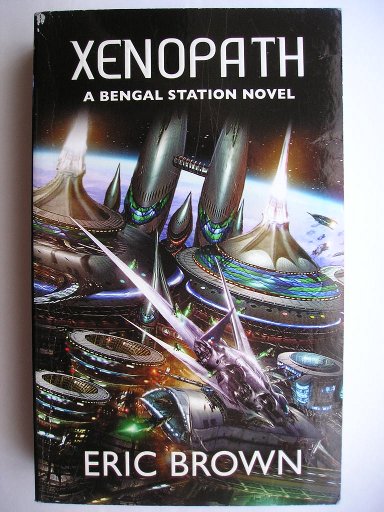
The novel “Xenopath” by Eric Brown was published for the first time in 2010. It’s the second book in the Bengal Station trilogy and is the sequel to “Necropath“.
Jeff Vaughan and Sukara got married and are expecting their first child. Their life isn’t easy because Jeff’s salary isn’t exactly rich but together they’re happy. Jeff’s days as a telepath now seem part of the past when he’s contacted by his former colleague Lin Kapinski, who opened a detective agency and offers him a job. The salary is very high but he needs to get a new neural implant to regain his old telepathic skills.
Jeff wouldn’t want to go back to the old days when he was always depressed but the new neural implant is more advanced than the old one and the pay will allow a much easier life for his family. He accepts the offer but his first case leads him to take an interest in the affairs of a corporation with interests in various planets. When the case gets officially closed, Jeff understands that this is a cover-up attempt and keeps on investigating, also to find Pham, a little girl who witnesses a murder, before the killer.
“Necropath”, with all its science fiction elements, was a hard-boiled detective story with noir tones in which the protagonists had a decidedly troubled life. In “Xenopath”, set about two years later, the tone changes completely. Jeff Vaughan and Sukara met and found mutual support that has finally allowed them to find happiness. If in “Necropath” the tone was depressed, in “Xenopath” is sometimes even a bit corny.
Instead, “Xenopath” is rather like “Necropath” in the structure of the story. Abandoned the noir tones, Eric Brown has written a science fiction detective story set for the most part on Bengal Station, one of the Earth’s spaceports in a future where interstellar travel is normal. Again, some aliens are involved and only gradually in the course of the novel their role is understood, partly thanks to a trip to the planet Mallory.
“Necropath” tells the initially parallel stories of Jeff Vaughan and Sukara. In “Xenopath” the second plot is dedicated to Pham, a little girl who works in Bengal Station and is looking for something better in her life. After witnessing a murder, her life is in danger and her story start intersecting with that of Jeff and Sukara.
Those who had already read “Necropath” could notice that the novel was definitely character-oriented and the plot was used to develop the protagonists. This is true again in “Xenopath”, where another time the detective story isn’t particularly bright and events seem often used to offer some new character development.
For example, Lin Kapinski doesn’t seem particularly competent for a person who runs her own private detective agency and that gives Jeff Vaughan a way of being the true protagonist of their investigation. The most interesting plot twists are connected to the aliens but in some cases they seem too convenient for some protagonist. Even the ending is in some ways predictable and reflects the tone of the novel.
Instead, Eric Brown is good at telling the story in a fluid way so the reading of the 400 pages of the novel is easy and allows the reader to sympathize with the protagonists. There’s also a lot of action for a pace that is generally fast, also because it’s not hard science fiction so the author doesn’t stop to describe future technologies.
“Xenopath” is the second novel in a trilogy. The story is independent from the previous one and has its own end so it may be read without first reading “Necropath”. However, since these stories are strongly character-oriented I suggest to start reading the first novel to be able to appreciate the development of the characters also between it and its sequel.
Despite some flaws, in my opinion “Xenopath” is overall a good novel that, along with “Necropath”, in particular readers interested in character-oriented stories may like.


Permalink